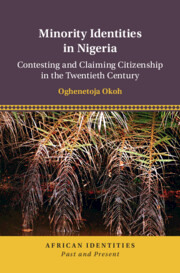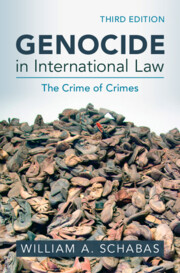Refine search
Actions for selected content:
140 results
4 - The UK Iraqi Diaspora: Institution-Building and Governance
-
- Book:
- Diasporic State-Building
- Published online:
- 25 November 2025
- Print publication:
- 18 December 2025, pp 99-143
-
- Chapter
- Export citation
Epilogue
-
- Book:
- Minority Identities in Nigeria
- Published online:
- 26 September 2025
- Print publication:
- 16 October 2025, pp 205-209
-
- Chapter
- Export citation
5 - Defining Minorities on the Eve of Nigerian Independence
-
- Book:
- Minority Identities in Nigeria
- Published online:
- 26 September 2025
- Print publication:
- 16 October 2025, pp 165-204
-
- Chapter
- Export citation
The power to disempower: The government of caste and the career of Dr Sathiavani Muthu in Tamil Nadu, circa 1960–1979
-
- Journal:
- Modern Asian Studies , First View
- Published online by Cambridge University Press:
- 07 October 2025, pp. 1-30
-
- Article
-
- You have access
- Open access
- HTML
- Export citation

Minority Identities in Nigeria
- Contesting and Claiming Citizenship in the Twentieth Century
-
- Published online:
- 26 September 2025
- Print publication:
- 16 October 2025
To Listen and to Belong. A Personal Take on Constitutionalism at Work Today
-
- Journal:
- German Law Journal / Volume 26 / Issue 2 / March 2025
- Published online by Cambridge University Press:
- 01 September 2025, pp. 350-360
-
- Article
-
- You have access
- Open access
- HTML
- Export citation
The impact of COVID-19 on parents from Black ethnic backgrounds in the UK: what we have learned and why it still matters
-
- Journal:
- BJPsych Open / Volume 11 / Issue 4 / July 2025
- Published online by Cambridge University Press:
- 08 July 2025, e143
-
- Article
-
- You have access
- Open access
- HTML
- Export citation
Where do the Forest Germans Live? Determining the Boundaries of a Forgotten Settlement Region in Southern Poland
-
- Journal:
- Nationalities Papers , FirstView
- Published online by Cambridge University Press:
- 29 May 2025, pp. 1-26
-
- Article
-
- You have access
- Open access
- HTML
- Export citation
2 - The League of Nations and the Global Legal Order
-
-
- Book:
- The Cambridge History of International Law
- Published online:
- 01 May 2025
- Print publication:
- 29 May 2025, pp 41-67
-
- Chapter
- Export citation
16 - Minorities, Refugees and Human Rights
-
-
- Book:
- The Cambridge History of International Law
- Published online:
- 01 May 2025
- Print publication:
- 29 May 2025, pp 501-554
-
- Chapter
- Export citation
6 - Sovereignty, Territory and Jurisdiction
-
-
- Book:
- The Cambridge History of International Law
- Published online:
- 01 May 2025
- Print publication:
- 29 May 2025, pp 162-195
-
- Chapter
- Export citation
“I Respect the Rules of my Home Country”: Performing Čisti Hrvatski and Exemplary Minority Subjectivity
-
- Journal:
- Nationalities Papers , FirstView
- Published online by Cambridge University Press:
- 23 May 2025, pp. 1-16
-
- Article
-
- You have access
- Open access
- HTML
- Export citation
22 - The Ottoman Encounter and the Law of Nations in the Old Regime
- from Part II - International Law in Old Regime Europe (1660–1775)
-
-
- Book:
- The Cambridge History of International Law
- Published online:
- 22 April 2025
- Print publication:
- 08 May 2025, pp 711-737
-
- Chapter
- Export citation
Japan's Rightward Swing and the Tottori Prefecture Human Rights Ordinance
-
- Journal:
- Asia-Pacific Journal / Volume 11 / Issue 9 / February 2013
- Published online by Cambridge University Press:
- 07 May 2025, e3
-
- Article
-
- You have access
- Open access
- Export citation
Introduction
-
- Book:
- Genocide in International Law
- Published online:
- 14 March 2025
- Print publication:
- 03 April 2025, pp 1-13
-
- Chapter
-
- You have access
- HTML
- Export citation
1 - Origins of the Legal Prohibition of Genocide
-
- Book:
- Genocide in International Law
- Published online:
- 14 March 2025
- Print publication:
- 03 April 2025, pp 14-42
-
- Chapter
- Export citation

Genocide in International Law
- The Crime of Crimes
-
- Published online:
- 14 March 2025
- Print publication:
- 03 April 2025
12 - Addressing Statelessness through the Human Rights and Development Frameworks
- from Part III - Challenges and Prospects for Change
-
-
- Book:
- Statelessness in Asia
- Published online:
- 19 December 2024
- Print publication:
- 23 January 2025, pp 302-327
-
- Chapter
- Export citation
1 - What Is Constitutional Intolerance?
-
- Book:
- Constitutional Intolerance
- Published online:
- 09 January 2025
- Print publication:
- 23 January 2025, pp 1-16
-
- Chapter
- Export citation
9 - Conclusion
-
- Book:
- Constitutional Intolerance
- Published online:
- 09 January 2025
- Print publication:
- 23 January 2025, pp 143-156
-
- Chapter
- Export citation
